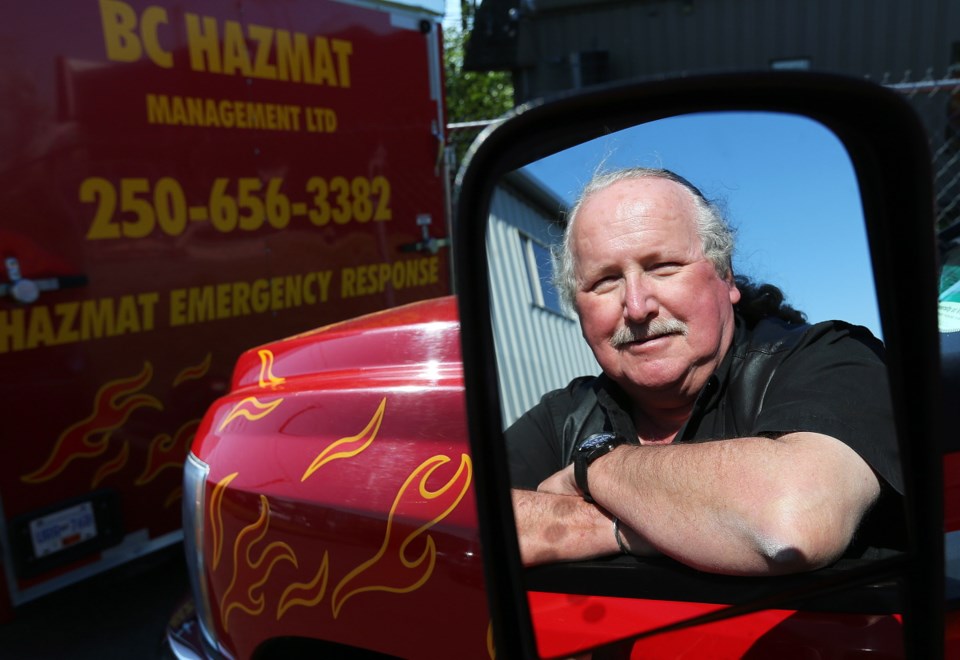David Rogers sent a transport container loaded with enough gear to handle a massive fuel, oil or hazardous material spill to a liquefied natural gas plant in Kitimat earlier this year.
He’s convinced it won’t be the last $100,000 shipment to the north.
The president of Sidney-based B.C. Hazmat Management expects his company will be tapped for more materials, training and spill management expertise as the province’s energy industry ramps up.
Rogers is also convinced B.C. will eventually see a pipeline carrying Alberta’s oilsands crude to northern ports. “We know there will be a pipeline. We know there will be more tankers. Right now, there are 250 tankers going up and down our coast, and I know we will have a spill,” Rogers said. “The Exxon Valdez [in 1989] was the last major spill on our coast. We are well overdue for it.”
And that’s why Rogers’ firm, which has specialized in safety training, spill management and hazardous goods shipping for 13 years, is gearing up.
In the safety game, preparation is everything.
B.C. Hazmat has already developed a Shoreline Cleanup Assessment Techniques course to train personnel to deal with oil spills and ensure maximum oil recovery while minimizing ecological damage.
And the company works in concert with other hazardous materials firms and agencies like the coast guard to ensure there’s as much equipment and know-how available on the ground when trouble strikes.
But Rogers said there’s still not enough.
As for the spill-response containers, Rogers’ firm also makes site visits to train staff on the ground how to react and how to use the equipment.
Even without a pipeline, Rogers’ business has been pushed to grow. This year, to recognize him for building the Island’s largest safety training facility, Rogers was named the Greater Victoria Chamber of Commerce Business Person of the Year.
For 12 years, B.C. Hazmat ran from the family home, but the need for larger training space required them to find about 6,000 square feet in Sidney. The company has seven full-time employees and a large roster of trained on-call staff who are pulled into action when there’s a spill. From it’s Sidney facility, the company builds spill-response containers and trailers that are sold and shipped ready to be deployed. It also packages and ships dangerous goods and develops and runs safety training courses for all sectors. “We ran successfully from home for 12 years in an industry that shouldn’t run from home,” Rogers said with a nod to the massive response trucks and trailers that dot the company’s parking lot. “Basically, we had fantastic neighbours.”
The new digs last summer came at the right time. The business has been booming.
“I’ve been surprised in the last year how much it’s grown,” he said, noting it seemed to start during the economic downturn in 2008.
Rogers said a combination of environmental awareness, vigilance and a large number of aging home heating fuel tanks are a big part of that growth. “We are going to see a lot more of those home oil spills,” he said. “Those are still happening. A lot of those old tanks are underground and were not remediated properly and a lot of them are still in use.”
But it’s not all oil and gas. “Every time that phone rings I never know what we’re going to get,” Rogers said. In the last few years, that’s included the Columbia Fuels spill near Goldstream, a $1 million cleanup of a residential fuel spill and an ugly sewage back-up that meant a number of condominiums had to be stripped down to the studs.
“That’s not normally our line of work, but when the septic guy won’t go into it, that’s when we get called,” Rogers said, adding their biggest concern was slipping in sewage that was settling more than 18 inches high inside the unit. “I still don’t know how the units above in that building didn’t smell it.”
The most dangerous incident was probably the Goldstream rollover.
“I had my team standing in sharp shale in 12 inches of gasoline with 24 inches of firefighting foam on top of it and directed them to keep on working,” he said.
Rogers, a former Whistler fire chief, is a safety proponent. Even though he has trained hundreds to respond quickly to disaster, he said personal safety comes first. “I’d say when I’m doing training sessions it’s three-quarters about how you can be safe and one-quarter about how to clean it up,” he said. “There’s nothing we can’t fix for Mother Nature. We can’t replace arms and legs.”



